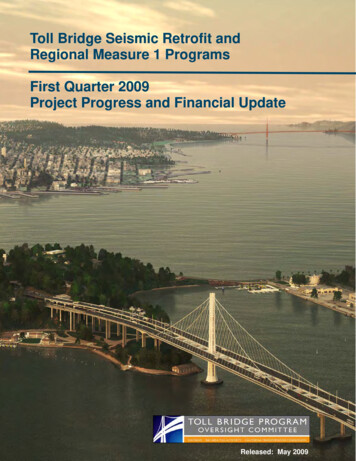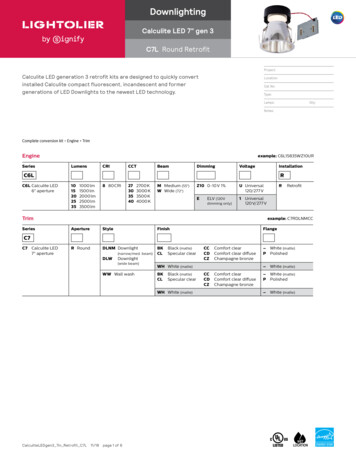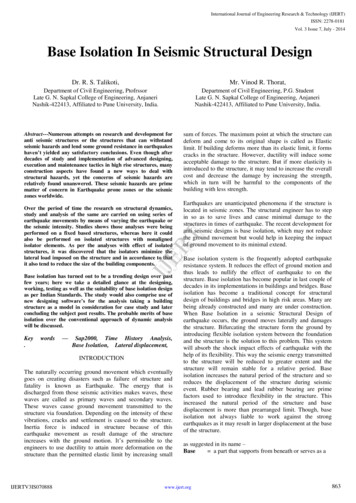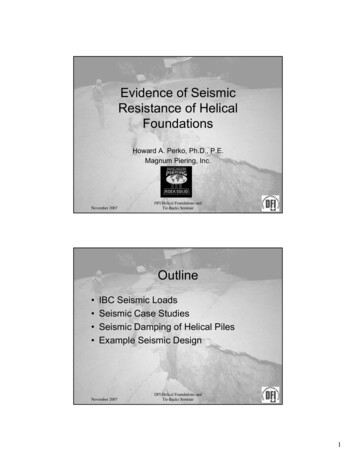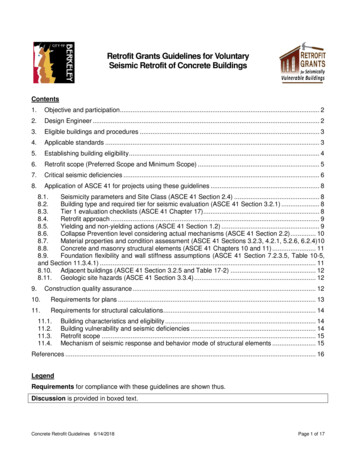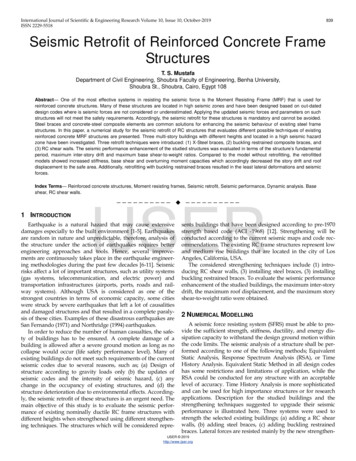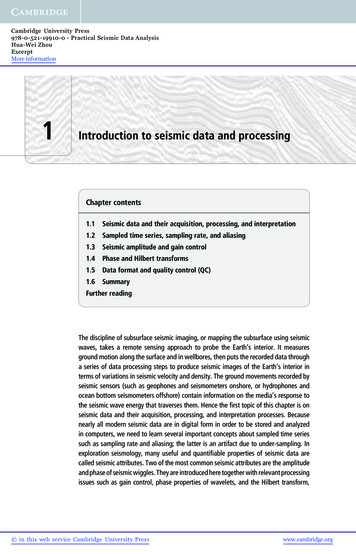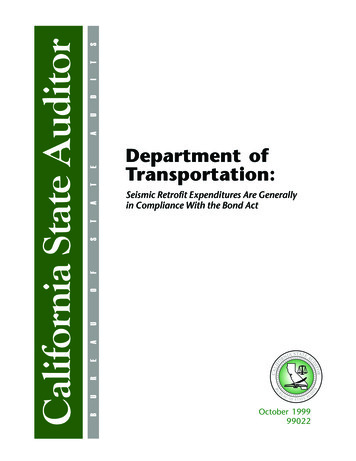
Transcription
Department ofTransportation:Seismic Retrofit Expenditures Are Generallyin Compliance With the Bond ActOctober 199999022
The first copy of each California State Auditor report is free.Additional copies are 3 each. You can obtain reports by contactingthe Bureau of State Audits at the following address:California State AuditorBureau of State Audits555 Capitol Mall, Suite 300Sacramento, California 95814(916) 445-0255 or TDD (916) 445-0255 x 216ORThis report may also be availableon the World Wide Webhttp://www.bsa.ca.gov/bsa/Permission is granted to reproduce reports.
CALIFORNIA STATE AUDITORKURT R. SJOBERGMARIANNE P. EVASHENKSTATE AUDITORCHIEF DEPUTY STATE AUDITOROctober 7, 199999022The Governor of CaliforniaPresident pro Tempore of the SenateSpeaker of the AssemblyState CapitolSacramento, California 95814Dear Governor and Legislative Leaders:As required by Chapter 310, Statutes of 1995, the Bureau of State Audits presents its audit reportconcerning the Department of Transportation’s (department) revenues and expenditures authorized by theSeismic Retrofit Bond Act of 1996 (Bond Act). This report concludes that the department, in general, hasensured that seismic retrofit projects funded with bond proceeds are consistent with the purpose of theBond Act. In fiscal year 1999-2000, the department plans to begin reimbursing the State HighwayAccount and the Consolidated Toll Bridge Fund for expenditures incurred during fiscal years 1994-95and 1995-96.Respectfully submitted,KURT R. SJOBERGState AuditorBUREAU OF STATE AUDITS555 Capitol Mall, Suite 300, Sacramento, California 95814 Telephone: (916) 445-0255 Fax: (916) 327-0019
CONTENTSSummary1Introduction3Audit ResultsAlthough Seismic Retrofit Projects WereValid, Not All Expenditures Were Eligiblefor Bond Act Funding9Appendix AStatus of the Seismic Retrofit Program13Appendix BBond Act Expenditures as of June 30, 199915Response to the AuditBusiness, Transportation and Housing Agency17
SUMMARYRESULTS IN BRIEFLegislation passed in 1995 requires the California StateAuditor to ensure that projects funded by the SeismicRetrofit Bond Act of 1996 (Bond Act) are consistent withthat measure’s purposes, which are to reconstruct, replace, orretrofit state-owned highways and bridges, including tollbridges. This is the fourth in a series of annual reports on theDepartment of Transportation’s (department) revenues andexpenditures, authorized by the Bond Act, for retrofittingCalifornia’s highways and bridges.As of June 30, 1999, the department had spent 1.14 billion forprojects on more than 1,100 bridges and 7 state-owned tollbridges, completing 96 percent of the retrofitting for highwaybridges and having all of the toll bridges either in retrofit designor under construction. In general, the department has done agood job of ensuring that seismic retrofit projects do meet thecriteria for funding under the Bond Act. However, we found thatnot all expenditures charged to those projects were eligible forsuch funding. Through minor recording errors, the departmentincorrectly charged approximately 38,000 for expenses notallowed under the Bond Act.Also, the department has not resolved a long-standing issue ofreimbursing other accounts for interim funding obtained duringfiscal years 1994-95 and 1995-96. During those years, the StateHighway Account (highway account) and the Consolidated TollBridge Fund (toll bridge fund) provided a total of 114 millionin expenditures and commitments for retrofitting California’sbridges. The Bond Act requires that the department use bondproceeds to reimburse the highway account and the toll bridgefund for these prior expenditures.In attempting to make the reimbursements, however, the department discovered two objections: one by the State Treasurer’sOffice, which pointed to a possible loss of the bonds’ tax-exemptstatus; and a second by the Department of Finance, whichobjected that the department’s source of reimbursement fundsCALIFORNIASTATEAUDITOR1
could be used only for current expenditures. Although both ofthese objections were removed by provisions in 1997 legislation,the department had not taken any action as of June 30, 1999, toreimburse the expenses.AGENCY COMMENTSIn their response, the department addressed the current statusof reimbursing other accounts for interim funding obtainedduring fiscal years 1994-95 and 1995-96. The departmentacknowledged that it originally planned to reimburse the highway account and toll bridge fund during fiscal year 1998-99.However, the department states that the criteria it developed toselect the projects to facilitate this reimbursement process wascomplex and required additional time. Therefore, the department currently anticipates that it will accomplish thisreimbursement in fiscal year 1999-2000. 2CALIFORNIASTATEAUDITOR
INTRODUCTIONBACKGROUNDSince the 1971 Sylmar earthquake struck the Los Angelesarea, the Department of Transportation (department) hasbeen engaged in a statewide seismic retrofit program forbridges. Seismic retrofit involves structural analysis to determinea bridge’s potential vulnerability during earthquakes and astrategy meeting with engineers to discuss the extent and natureof retrofit approaches and to determine the final retrofit design.Current retrofit work includes strengthening the columns ofexisting bridges by encircling them with a steel casing, enlargingand strengthening some of the bridge footings by placing additional pilings in the ground or by using steel tie-down rods tobetter anchor the footings to the ground, and enlarging thehinges that connect sections of bridge decks to help preventthem from separating during severe ground movement.Before the January 1994 Northridge earthquake, the departmentclassified all state-owned highway bridges (except toll bridges)into two groups: single-column bridges and multiple-columnbridges. After the Northridge earthquake, the department reclassified the bridges into Phase I and Phase II categories. Phase Iincludes bridges determined in the strategy process to haverequired retrofitting as of January 1, 1994; these bridges are thusnot eligible for funding from the Seismic Retrofit Bond Act of1996 (Bond Act). Phase II includes all of the remaining stateowned bridges (excluding toll bridges), for which no retrofitstrategy was in place by January 1, 1994.In March 1996, California voters approved the Bond Act, whichauthorized the State to sell 2 billion in state general-obligationbonds to reconstruct, replace, or retrofit Phase II bridges andstate-owned toll bridges. The Bond Act will remain in effect untilall construction activities for the seismic retrofit of state-ownedtoll bridges are complete or until June 30, 2005, whichever issooner. Figure 1 depicts the State’s continuing seismic retrofitactivity and its relationship to the Bond Act.CALIFORNIASTATEAUDITOR3
FIGURE 1Retrofit Activity: 1971 to the PresentCONTINUINGRETROFITACTIVITYPhase II andtoll bridge retrofittingInterim funding fromPooled MoneyInvestment Account loanInterim funding fromState Highway AccountandConsolidated Toll Bridge Fund1971199419891996Bond ActapprovedSylmarLoma Prieta Northridgeearthquake earthquake earthquake1997Bonds issued inMarch and October1998Bonds issuedin October1999Bonds issuedin February,April, and JunePhase IIcategory establishedACTIVITIES FUNDED WITH BOND PROCEEDSThe Bond Act initially required the department to use 650 million of the bond proceeds for seismic retrofit of toll bridges andthe remaining 1.35 billion for Phase II retrofits. However, onAugust 20, 1997, the governor signed into law Chapter 327,Statutes of 1997, which effectively shifted the allocation ofexpenditures in the Bond Act to 790 million for toll bridgesand 1.21 billion for Phase II retrofits. Since the estimate toretrofit or replace the state-owned toll bridges is 2.62 billion,the legislation also authorized additional funds from variousstate and toll bridge revenue accounts for retrofitting the seventoll bridges.The Bond Act also requires the department to use bond proceedsto reimburse the State Highway Account and the ConsolidatedToll Bridge Fund, which, along with other state funds, providedapproximately 114 million in interim funding for fiscal years1994-95 and 1995-96 expenditures for Phase II and tollbridge retrofits.In fiscal year 1996-97, the Seismic Retrofit Bond Fund of 1996was created to account for seismic retrofit expenditures andrevenues. Before bonds can be issued, this fund uses loans fromthe State Pooled Money Investment Account to cover expenditures made by the seismic retrofit program. As Figure 2 indicates,the funding of these expenditures is very complex, involvingtemporary funding until bonds are issued.4CALIFORNIASTATEAUDITOR
FIGURE 2The Use of Funds for Bond Fund ExpendituresState Treasurer's countAccountECommercialpaper oanestablishedGLiability paid offExpendituresreimbursedBCTransportationRevolving AccountSeismic RetrofitBond FundAContractorpaidContractorA Seismic retrofit expenditures are originally paid from the Transportation Revolving Account.B The State's Pooled Money Investment Account (PMIA) loan program provides interim financing to Bond Actprojects. As of June 30, 1999, the department had received PMIA loans totaling 1.3 billion, all of which wereapproved by the Pooled Money Investment Board.C The department uses PMIA loan funds and submits a monthly transfer letter, based on a Plan of FinancialAdjustment, to the State Controller's Office to reimburse the Transportation Revolving Account from theSeismic Retrofit Bond Fund for the month's expenditures.D The State Treasurer's Office sells commercial paper in the amount of the previous period's expendituresrecorded in the Seismic Retrofit Bond Fund. Commercial paper is simple, short-term promissory notes withmaturities ranging from 1 to 270 days.E The proceeds of these commercial paper sales are used to pay down the outstanding balance of the PMIA loanto the department.F The State Treasurer's Office sells general obligation bonds when the market is favorable.G The State Treasurer's Office uses the proceeds from bond sales to pay off the liability for the commercial paper.CALIFORNIASTATEAUDITOR5
STATUS OF THE BOND ISSUANCESSince the inception of the seismic retrofit program, the State hasissued six general obligation bonds under the Bond Act. Table 1shows the date and amount of each issuance.TABLE 1Seismic Retrofit Bond Act:General Obligation Bond IssuancesBond SeriesDate SoldAmount SoldSeries A03/18/97 50,005,000Series B10/08/97300,000,000Series C10/07/98344,850,000Series D02/23/99100,000,000Series E04/07/9976,000,000Series F06/09/9920,000,000Total 890,855,000SCOPE AND METHODOLOGYChapter 310, Statutes of 1995, requires the California StateAuditor to annually audit revenues and expenditures authorizedby the Bond Act to ensure that the projects funded are consistent with the act’s purpose.To gain an understanding of the seismic retrofit program, wereviewed the Bond Act’s provisions and the related policies andprocedures developed by the department for expenditurescharged to the Seismic Retrofit Bond Fund of 1996. We alsointerviewed administrators and staff to determine their responsibilities for implementing provisions of the Bond Act and theirmanner of meeting those responsibilities.To determine how fully the department complied with therequirements of the Bond Act, we reviewed a sample of seismicretrofit projects for fiscal year 1998-99 and assessed whether theprojects were eligible for funding. In addition, we reviewed asample of the 1.14 billion in seismic retrofit expendituresrecorded as of June 30, 1999, for all years combined.6CALIFORNIASTATEAUDITOR
We also followed up on the issues raised by the State Treasurer’sOffice and the Department of Finance regarding the federal taxand fiscal implications of using bond proceeds to reimbursefiscal years 1994-95 and 1995-96 Phase II seismic retrofit expenditures. We reviewed the department’s records and interviewedadministrators to determine whether any reimbursement hastaken place.Finally, we reviewed bond-issuance records available throughAugust 1999 to determine their status and use. CALIFORNIASTATEAUDITOR7
Blank page inserted for reproduction purposes only.8CALIFORNIASTATEAUDITOR
AUDIT RESULTSAlthough Seismic Retrofit ProjectsWere Valid, Not All ExpendituresWere Eligible for Bond Act FundingSUMMARYWe reviewed a sample of 32 projects and 50 expenditures charged to these projects by the Department ofTransportation (department) for fiscal year 1998-99.We found that while the projects and most of the expenditureswere appropriate under the Seismic Retrofit Bond Act of 1996(Bond Act), some expenditures were in error. Specifically, wefound that the department erroneously charged approximately 38,000 to Bond Act projects for expenses it should haverecorded elsewhere.As reported in our last two audits, the department encountereddifficulties with the Bond Act requirement to reimburse the StateHighway Account (highway account) and the Consolidated TollBridge Fund (toll bridge fund) for funds the department used forseismic retrofit expenditures in fiscal years 1994-95 and 1995-96.Specifically, the State Treasurer’s Office and the Department ofFinance had raised valid objections to the department’s methodof reimbursement. In 1997, new legislation removed thoseobjections, allowing the department to use Bond Act revenues toreimburse the highway account and the toll bridge fund, andthe department indicated that it would begin payments in fiscalyear 1998-99. However, our review of the department’s recordsthrough June 30, 1999, found that it had not begun thereimbursement process.BACKGROUNDAs of June 30, 1999, department records showed that 559 activeseismic retrofit projects related to 1,155 Phase II bridges and7 toll bridges were eligible to use Bond Act revenues. The department has retrofitted 96 percent of the Phase II bridges. Thedepartment has also completed 2 of the 13 construction contracts that it currently has for retrofitting 6 of the state-ownedCALIFORNIASTATEAUDITOR9
toll bridges. In addition, the department projects that it willaward all contracts for the San Francisco-Oakland Bay Bridge,the seventh state-owned toll bridge, by 2001. Appendix A showsthe status of the seismic retrofit program. As of June 30, 1999,the department had recorded over 1.14 billion in expendituresfor both types of projects funded with Bond Act revenues.Appendix B shows the breakdown of these expenditures.NOT ALL EXPENDITURES WERE ELIGIBLEFOR BOND ACT FUNDINGAlthough most of the expenditures we reviewed were properlycharged to the Seismic Retrofit Bond Fund of 1996, we foundallocation and coding errors that caused inappropriate charges.For one of the 50 expenditure transactions we reviewed, thedepartment incorrectly charged approximately 6,700 to aPhase II project that should have been charged to a Phase Iproject. This error occurred because the department failed toidentify that, unlike most of its contracts, this contract forprofessional services benefited several projects, thus requiringthe department to allocate the 392,262 that it paid for theseservices to a combination of Phase I, Phase II, and toll bridgeseismic retrofit projects. After we discussed this allocation withthe department, it corrected its mistake by transferring approximately 6,700 from Phase II to Phase I projects.In addition, we found that the department erroneously chargedto a seismic retrofit project a total of 31,066 for legal services todefend the department in a right-of-way lawsuit related to anonseismic project. This mistake occurred because the department made a keying error when entering the project code. Thedepartment did not identify the error because it failed to followits review procedures for right-of-way capital outlay expenditures.After we discussed this coding error with the department, it madean adjusting entry to charge the expenditure to the correct project.These two errors seem to be the result of isolated breakdownsin the department’s system of ensuring that only eligible expenditures are charged to the Bond Act and are not pervasivethroughout the seismic retrofit expenditures.10CALIFORNIASTATEAUDITOR
The Department Has Not Yet ReimbursedEarly Seismic Retrofit ExpendituresArticle 2 of the Bond Act requires that bond proceeds be used toreimburse the highway account and the toll bridge fund forseismic retrofit expenditures during fiscal years 1994-95 and1995-96. Department records show approximately 114 millionin expenditures and commitments for seismic retrofit duringthese two fiscal years. This total included 103 million from thehighway account and 11 million from the toll bridge fund.However, as we stated in previous reports, the departmentfound two problems that prevented it from complying withthis requirement.First, the State Treasurer’s Office raised the concern that reimbursing these past expenditures with bond proceeds wouldjeopardize the bonds’ federal tax-exempt status, potentiallyobligating the State, if the tax-exempt status were lost, to paybond purchasers a higher interest rate to compensate them forpaying federal taxes on interest earnings. According to theState’s bond counsel, under treasury regulation, an issuerwanting to use the proceeds of tax-exempt bonds to reimburseexpenditures must adopt a resolution of official intent no laterthan 60 days after the payment of the original expenditures,indicating that it expects to reimburse the expenditures withbond proceeds. Because the 60-day window for the early retrofitexpenditures has long since passed without the required officialresolution, the reimbursement of expenditures does not meetthe requirements for tax exemption.Further, because of fiscal considerations, the Department ofFinance objected to using Pooled Money Investment Accountloans to provide interim reimbursement to the highway accountand the toll bridge fund for fiscal years 1994-95 and 1995-96seismic retrofit expenditures. Loan provisions require thatthis possible source of reimbursement be used for currentexpenditures only.In August 1997, new legislation offered a solution to the problem of preserving the tax-exempt status of the bonds, whilemeeting the legal reimbursement requirements. Chapter 327,Statutes of 1997, authorizes the use of 745 million from thehighway account to finance seismic retrofit projects for tollbridges. According to the chief of the department’s Office ofFinance and Capital Budgets, because the new legislationrequires highway account contributions for toll bridge retrofits,CALIFORNIASTATEAUDITOR11
the department plans to use 103 million of bond proceeds topay for future costs of this type. In addition, the departmentintends to fund 11 million of future toll bridge fund projectswith Bond Act revenues. This allows the department to use BondAct proceeds to reimburse the highway account and the tollbridge fund for the 114 million in seismic retrofit expendituresincurred during fiscal years 1994-95 and 1995-96. Furthermore,the 1997 legislation also addresses the Department of Finance’sconcerns because it allows Pooled Money Investment Accountloans to temporarily fund future seismic retrofit projects untilbonds are issued.The Seismic Retrofit Finance Committee, which is responsiblefor the administration of Bond Act financing programs, approvedthe department’s use of these funds on November 19, 1997. Yet,when we reviewed the department’s records, we determined thatno actual reimbursement had taken place as of June 30, 1999.According to the department, it has not begun the reimbursement because selecting the best possible projects to facilitate thisreimbursement is a complex process. More specifically, thedepartment is currently reviewing its project inventory to selectonly projects that are scheduled for construction and completion within the life of the Bond Act, which ends on June 30, 2005.The department intends to complete the selection of projects bythe end of fiscal year 1999-2000.We conducted this review under the authority vested in the California State Auditor bySection 8543 et seq. of the California Government Code and according to generally acceptedgovernment auditing standards. We limited our review to those areas specified in the auditscope section of this report.Respectfully submitted,KURT R. SJOBERGState AuditorDate: October 7, 1999Staff:12Denise L. Vose, CPANasir Ahmadi, CPAAnna EscuadroCALIFORNIASTATEAUDITOR
APPENDIX AStatus of the Seismic Retrofit ProgramTables 2 and 3 depict the status of the seismic retrofitprogram for both Phase II bridges and toll bridges asof July 1, 1999.TABLE 2Status of Phase II Bridges as of July 1, 61Totals1,10922241,155Source:CALIFORNIASeismic Retrofit Program: Summary Status, issued by the Departmentof Transportation.STATEAUDITOR13
TABLE 3Status of Toll Bridges as of July 1, 1999Number ofProjectsToll FacilityCurrent RetrofitCompletion DateCurrent StatusSan Francisco-Oakland Bay Bridge:East Bay spanTo be determinedDesignSpring 2005West Bay span7Construction/designSummer 2005Benicia-Martinez Bridge2Under constructionSummer 2001San Mateo-Hayward Bridge4Under construction/designSpring 2001Richmond-San Rafael Bridge1DesignWinter 2004Carquinez Bridge (eastbound)1Under constructionSummer 2000Vincent Thomas Bridge1Under constructionWinter 2000San Diego-Coronado Bridge4Under construction/designWinter 2002Source:14Seismic Retrofit Program: Summary Status, issued by the Department of Transportation.CALIFORNIASTATEAUDITOR
APPENDIX BBond Act Expenditures as ofJune 30, 1999Table 4 shows the breakdown of seismic retrofit expenditures by fiscal year as of June 30, 1999.TABLE 4Breakdown of Seismic Retrofit Expenditures as of June 30, 1999(in 995-96 9Total(All Years)Phase II bridgesState operationsAdministrationLegalOperationsCapital outlay—supportSubtotal00012,452 7,2480070,609 18,3140080,542 24,0380134,928 5,73254,468106,206200,203432,466 33,494 79,080 322,717 380,082 325,088 1,140,461Capital outlayMajor constructionMajor contractsMinor construction (A&B)Minor contracts (A&B)Right-of-waySubtotalTotal Phase II00019,248Toll bridgesState operationsAdministrationLegalOperationsCapital outlay—supportSubtotalCapital outlayMajor constructionMajor contractsMinor construction (A&B)Minor contracts (A&B)Right-of-waySubtotalTotal toll bridgesGrand TotalCALIFORNIASTATEAUDITOR15
Blank page inserted for reproduction purposes only.16CALIFORNIASTATEAUDITOR
(Agency’s response provided as text only:)Business, Transportation and Housing Agency980 9th Street, Suite 2450Sacramento, California 95814-2719September 29, 1999Kurt R. Sjoberg, State AuditorBureau of State Audits555 Capitol Mall, Suite 300Sacramento, CA 95814Dear Mr. Sjoberg:Attached is the Department of Transportation’s (Caltrans) response to your reportentitled “Department of Transportation: Seismic Retrofit Expenditures Are Generally inCompliance with the Bond Act,” report #99022. As identified in your report, I ampleased to report that Caltrans has done a good job of ensuring that seismic retrofitprojects are meeting the criteria for funding under the Seismic Retrofit Bond Act of1996.While the report also identified that Caltrans has not yet reimbursed the State HighwayAccount (SHA) and the Toll Bridge Fund for temporarily providing 114 million forseismic retrofit expenditures to California bridges from Proposition 192 funds, Caltranswill accomplish the reimbursement in fiscal year 1999-2000. Caltrans has chosen toselect specific projects consistent with Bond Act timeframes and also projects whichare 100% SHA or Toll Bridge funded to reduce the complexities of cost allocation. Thisprocess requires additional time to select specific projects meeting these criteria.If you have any questions, please let me know.Sincerely,(Signed by: Maria Contreras-Sweet)MARIA UDITOR17
Department of TransportationOffice of the Director1120 N StreetP. O. Box 942873Sacramento, CA 94273-0001September 29, 1999MARIA CONTRERAS-SWEET, SecretaryBusiness, Transportation and Housing Agency980 - 9th Street, Suite 2450Sacramento, CA 95814Dear Secretary Contreras-Sweet:I am pleased to provide our response to the State Auditor’s report on Seismic RetrofitExpenditures for fiscal year 1998/99. The audit report noted that seismic retrofit expenditures were generally in compliance with the Bond Act. Two minor recording errorstotaling approximately 38,000 were noted, which amount was immaterial when compared to total seismic retrofit expenditures of 1.14 billion.The State Auditor also reported on the status of the reimbursement of fiscal year 1994/95 and 1995/96 expenditures to the State Highway Account and Consolidated TollBridge Fund. The reimbursement issue was originally reported by the State Auditor inDecember 1997, in their audit report on seismic retrofit expenditures. Caltrans wouldlike to provide the following clarifying information on the current status of these reimbursements.Caltrans intended to accomplish the reimbursement of State Highway Account (SHA)and Toll Bridge Accounts from Proposition 192 funds during fiscal year 1998-99. However, in developing the criteria for choosing projects to be funded with Proposition 192funds, it became apparent that selecting very specific types of projects would greatlybenefit the management of the reimbursement process. Two key criteria for selectingSHA and Toll Bridge projects for funding with Proposition 192 funds are:Construction complete by June 30, 2005, the sunset date of Proposition 192 fundsInitially, large projects were considered to reduce the number of non-seismic retrofitprojects funded with Proposition 192 funds. However, many of the large projects thatwere considered are not scheduled to begin construction until close to the sunset dateof Proposition 192.Projects initially programmed as 100% SHA or Toll Bridge funded18CALIFORNIASTATEAUDITOR
Projects with a combination of funding sources such as state, federal and reimbursement funds create a more complex process for monitoring the Proposition 192 “share”of expenditures. Projects that include federal and reimbursement funding often requireexpenditure adjustments at the time of completion. This is attributable to the projectclose out process when final eligibility of expenditures for reimbursement by either thefederal government or local entities is determined.The above selection criteria made it more difficult than anticipated to develop thecandidate list of projects for funding with Proposition 192 funds. However, Caltrans hasnearly completed development of an inventory of SHA and Toll Bridge projects and willaccomplish the reimbursement in fiscal year 1999-00.If we can provide any further information, or if you have any questions, please do nothesitate to contact me.Sincerely,(Signed by: Tony V. Harris for Jose Medina)JOSE MEDINADirectorCALIFORNIASTATEAUDITOR19
cc:20Members of the LegislatureOffice of the Lieutenant GovernorAttorney GeneralState ControllerLegislative AnalystAssembly Office of ResearchSenate Office of ResearchAssembly Majority/Minority ConsultantsSenate Majority/Minority ConsultantsCapitol Press CorpsCALIFORNIASTATEAUDITOR
expenditures, authorized by the Bond Act, for retrofitting California's highways and bridges. As of June 30, 1999, the department had spent 1.14 billion for projects on more than 1,100 bridges and 7 state-owned toll bridges, completing 96 percent of the retrofitting for highway bridges and having all of the toll bridges either in retrofit design
